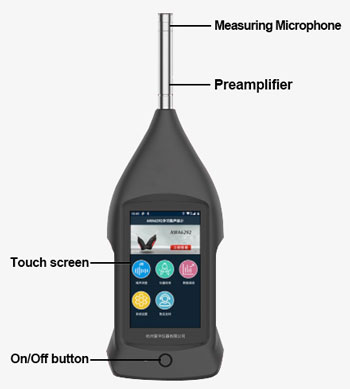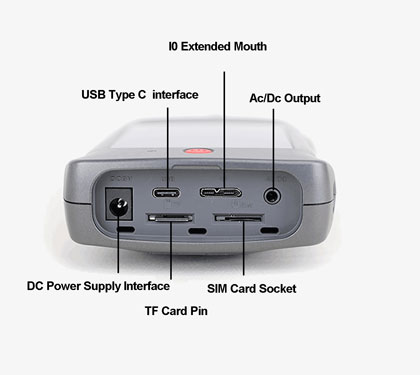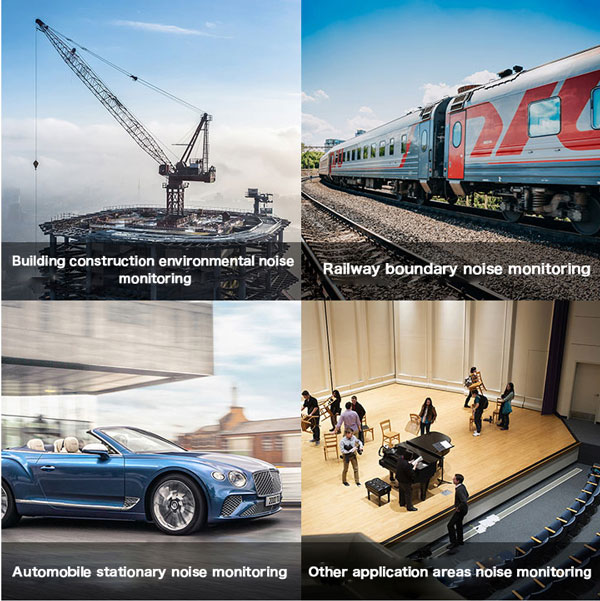Class 1 digital sound level meter with map positioning function, multiple data transmission methods, integrated 4G, WiFi, Bluetooth, serial port, USB, waterproof and dustproof design IP65, widely used in industrial machines and products noise measurement, environmental noise measurement and workplace noise measurement, etc.

Multifunctional sound level meter
- Simultaneous measurement of a variety of evaluation indicators, modular design.
- Digital signal processing technology and network technology of the new generation of noise measurement instruments.
- 20W fast charging, ultra-long standby, charging 2 hours to meet 1 time 24 hours measurement.

Ensure data security and validity
- Strong data security, encrypted data storage method.
- Super data analysis capability, support multiple functions at the same time measurement.
- Multiple data transmission methods, integrated 4G, WiFi, Bluetooth, serial, USB.
Applications
sisco multifunctional sound level can measure a variety of evaluation indicators at the same time, modular design, users can purchase the corresponding modules according to needs. The instrument is mainly used in industrial machinery and product noise measurement, environmental noise measurement, workplace noise measurement, airport noise measurement, and Hall acoustic characteristics measurement, etc.

| Model | SISCO-AWA-6292 |
| Microphone Model | Pre-polarization test condenser microphone |
| Measuring Range | 20 dB(A)~143 dB(A) |
| Frequency Range | 10 Hz~20 kHz |
| Frequency Weighting | Parallel (simultaneous) A, C, Z for each channel |
| Time Weighting | Parallel (simultaneous) F, S, I, Peak for each channel |
| Monitor | Touch screen |
| Main Measurement Functions | Total value integration, statistical integration, 24-hour automatic monitoring, 1/1 OCT, 1/3 OCT, FFT analysis, indoor measurement, reverberation time, STI, etc. |
| Main Measurement Index | Lxyp, Lxeq, T, Lxeq, t, Lxmax, Lxmin, LxN, SD, SEL, Lxpeak, etc. (Note: x is A, C, Z; y is F, S, I; N is 5, 10, 50, 90 , 95) |
| Main Display Content | Real-time measurement and display of more than 9 measurement indicators, statistical distribution graph, cumulative distribution graph, and 24-hour distribution graph |
| Data Storage Function | 16G internal storage, maximum support 64G TF card |
| Communication Interface | 4G, WIFI, Bluetooth, serial port, USB |
| Protection Level | IP65 (without microphone) |
| Battery Capacity | 10000mAh Lithium battery |
| Power Supply | 9V DC power supply (20W fast charge) |
| Weight | 910g |
| Operating Temperature | -40 ℃~40 ℃ |
| Warranty | 12 Months |
| Dimension | 28mm x 95mm x 40mm |
Q1: What is a noise detector?
A1: Noise tester is an instrument used for noise detection and testing in public places such as work sites and squares. Factory noise monitoring Noise pollution is one of the environmental pollutions that have a greater impact. Higher decibel noise can even cause serious damage to people's eardrums and cause deafness. The application of the noise tester can provide the decibel that the noise reaches in order to take relevant measures to control and reduce the noise. The measurement unit of the sound level is decibels. The professional noise tester has a highly sensitive sensor, high accuracy, and a wide range of applications. It can be widely used for noise measurement in various environments. Sound level measuring instrument, collectively referred to as sound level meter.
Q2: Sound level meter working principle
A2: The sound level meter uses a microphone to convert the sound into an electrical signal, and then a preamplifier converts the impedance to match the microphone with the attenuator. The amplifier adds the output signal to the weighting network, performs frequency weighting on the signal (or an external filter), and then amplifies the signal to a certain amplitude through the attenuator and amplifier, and sends it to the effective value detector (or external press Level recorder), give the value of the noise level on the indicator head.
Q3: How big is the decibel scale?
A3: Sound is measured in decibels (dB). Whispering is about 30 decibels, normal conversation is about 60 decibels, and motorcycle engines run at about 95 decibels. Noise above 70 decibels for long periods of time may begin to damage your hearing. Loud noises above 120 dB can cause immediate damage to your ears.
Tips: How does a digital sound level meter work?
A digital sound level meter uses a microphone to convert sound into an electrical signal, and then a preamplifier converts the impedance so that the microphone matches the attenuator. The amplifier adds the output signal to the weighting network, frequency weighting the signal (or external filter), and then the signal is amplified to a certain amplitude by the attenuator and amplifier, sent to the RMS detector (or external pressure level recorder), and the value of the noise level is given on the indicator head.
Thank you for buying industrial test and measurement equipment on SISCO.com, all products sold by SISCO and the partner cover a 12 months warranty, effective from the date of receiving the products.
What is covered?
SISCO is responsible for providing free spare parts, and free technical support to assist the customer to repair the defective products until the problem is solved.
What is not covered?
- Product purchased from anyone other than a SISCO store or a SISCO authorized reseller.
- Expendable parts.
- Routine cleaning or normal cosmetic and mechanical wear.
- Damage from misuse, abuse or neglect.
- Damage from use of parts other than SISCO approved.
- Damage from use outside the product’s usage or storage parameters.
- Damage from use of parts not sold by SISCO.
- Damage from modification or incorporation into other products.
- Damage from repair or replacement of warranted parts by a service provider other than a SISCO authorized service provider.
- Damage caused by the application environment not meeting the product usage requirements and the failure to perform preventive maintenance.

